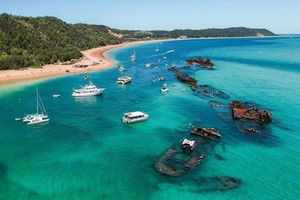
Pounding the streets, and jumping on and off the ferries and MTR is an exhilarating, and sometimes tiring, experience and Hong Kong is renowned for its unrelenting assault on the senses. There are so many images for the first-timer, and return visitor, to take in: traditional wooden boats bobbing on the harbour next to ferries and luxury cruise ships; decayed buildings cowering next to glass and steel skyscrapers; tired alleys meandering behind luxury hotels; old Chinese traders with wheel barrows pushing past late model BMWs and Mercedes.
With seven million inhabitants living elbow-to-elbow in a territory of just 1,100 square kilometres, it is possible to suffer from sensory overload and few visitors take advantage of the serenity and laid-back charm of Hong Kong’s “Outlying Islands”. There are a staggering 234 of them, although most are just uninhabited rocky outcrops, and the ones that do have human life are sparsely populated.One of note is Lamma Island, a vehicle-free oasis of calm just 25 minutes by ferry from Central, and it’s a great way to escape the non-stop madness of the metropolis.It’s also the third largest island in Hong Kong at just 13 square kilometres and is home to a mix of fishermen, farmers and commuters.
Walking trails criss-cross the island and pass by white sandy swimming beaches and elevated cliffs with stunning vistas of the ocean. After landing in the pretty village of Yung Shue Wan which is basically a main street with bars, restaurants and mini-markets, I’m setting out on a four kilometre trek - aiming for the fishing village of Sok Kwu Kwan to the south-east.It’s one of the more popular walks on the islands and the end reward is a selection of some of the best seafood restaurants in Hong Kong.Just outside Yung Shue Wan, we meet a local on the walking trail who’s heading for the same destination.
Within 20 minutes we’re at Hung Shing Yeh Beach, with clean white sand on a pretty bay with a swimming enclosure. It’s pretty much deserted.“Most tourists don’t realise we have this,” the local says, “And it’s probably just as well because it’s already packed with Hong Kong people on weekends.”We leave the beach and ascend through a mini-range on a concrete pathway with the occasional charming house at each side.
I’m told Lamma has a reputation as something of a hippie/bohemian hangout, but since Chinese rule that’s changed a bit. Rents are still cheap compared to Central and Kowloon but prices have edged up and tourism is now emerging as the main enterprise on the island. Just before the path steepens, we wander into a herb garden which operates as a business - the owners are a Chinese couple who are a bit of a throwback to Lamma’s past, although they could now be possibly described as “hippie-entrepreneurs”.
The path elevates upwards and skirts the edge of the cliff and offers stunning elevated views of the western side of Lamma with its rugged coastline and occasional secluded beach, usually at the bottom of a steep, rocky track. As we reach the peak and head down, the picture postcard image of Sok Kwu Kwan reveals itself - it’s getting late and the fishing boats are returning to the tiny port with their day’s catch.
We pass an old Tin Hau temple from the 1820’s and enter Sok Kwu Kwan, and on the waterfront about a dozen seafood restaurants jostle for business side-by-side - we’re apparently heading for Rainbow Restaurant.Each of the restaurants has massive fish tanks with an incredible array of live seafood to tempt customers in - locals appear happy to reach in and pick up crabs and shellfish for inspection. At least there are no concerns about how fresh the food is going to be.
We grab a table right on the water as the sun sets over the mountains behind us - the oranges and reds cast an ethereal hue through the calm waters of the bay - and we successfully manage to order some food with some Tsing Tao beers with some assistance from our waiter. Chinese food is the very essence of Hong Kong culture, and eating out is the favourite past-time for locals - often though the choice is overwhelming so dining with the locals can be very helpful.
We’re presented with plates of fresh scallops cooked in ginger, prawns with chilli, crab and a whole fish cooked in fresh herbs.It’s obvious we’re not going to make it to Tung O Wan - an idyllic bay a further 30 minutes walk to the south, and besides, the ferries back to Central arrive and depart from a pier just 50m away.It’s a busy port at sunset, and large groups of “suits” from the mainland pour off ferries and into the restaurant strip to check out the live seafood tanks and decide where to settle down for the evening.
There’s a certain “hustle and bustle” to this evening ritual, but at the same time there’s a decidedly laid-back atmosphere which can be missing from life on the “mainland”.A final round of local beer is delivered to our table and it’s the perfect way to finish the Lamma Island experience, and we watch as the ferry pulls into the bay - ready to return us to the chaos and clatter of the city.
- By:
- Ben Hall
Reviews
-
Loved This
Great article I've heard of Lamma but never been there.......such a shame what's happening in Hong Kong right now I hope things settle down so its safe to travel there again soon
-
No Idea
I had no idea there was such a place in Hong Kong, will have to check it out when we go back next year.










